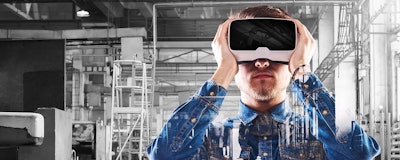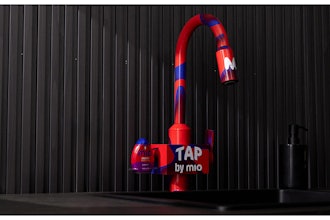
 Gavin Finn
Gavin Finn Ford Motor Company has used virtual reality (VR) for virtual prototyping allowing engineers all over the globe to collaborate in real time on designs before they are approved. Gabler uses VR to safety train its assembly line teams. Boeing uses augmented reality (AR) to help speed up the assembly process and reduce errors.
When engineering and manufacturing teams think about how AR and VR can play a role in their operations, they typically identify applications such as:
- VR for multi-person collaboration in design
- Manufacturing process development using AR
- AR for real-time assembly instructions
- VR for interference detection in complex assemblies
- AR for training personnel
- AR for service and technical support
These are all exciting and substantive opportunities for immersive technologies to improve quality, reduce design time and bring products to market faster. But can these same solutions also help companies to sell more of their products?
What are Immersive Solutions?
Most people can relate to the experience of being “presented to” by a sales person showing a slide presentation, which is not very engaging and ultimately not all that effective. When the prospect is actively involved, conversely, the same information is absorbed and remembered, and prospects and customers develop a deeper understanding of the material. This has been demonstrated when users engage with touch applications on iPads, large touch devices at trade shows and on the web. Not only does the user have sensory interaction (touch, visual and even auditory), but they also engage on two other dimensions: intellectual (the information being exchanged is useful and relevant) and emotional (the user has fun engaging with these applications, as opposed to sitting passively listening to someone else talk).
A step beyond this kind of interaction is immersion, in which there is a blending of the real world and the digital world. In AR, digital objects are placed into the real world, and the user sees these objects superimposed over their real-time view of the physical space around them. Users can use a wearable device, such as Google Glass, Meta or HoloLens, and the transparent glass also acts as a screen on which data are displayed. Another way to interact with AR applications is on phones and tablets, where the camera shows the physical space and the application puts digital objects or data into that space in a specific location.
In VR, the user dons a headset (which completely blocks out their view of the world around them) and a digital world is visible, in which the user can look around from any angle, and even move through the digital space and interact with objects in that space.
Why Sales?
In 2017, Sirius Decisions reported that B2B salespeoples’ No. 1 challenge is, “their inability to communicate value differentiation.”
It’s not enough that manufacturing companies can build advanced products with capabilities that can be used to solve customers’ problems — the customers must somehow determine how the product can help them in their unique circumstances. Simply describing the features (commonly referred to as “feeds and speeds”) is no longer sufficient. As products and technologies have become more complex, it has become more difficult for manufacturing companies to succinctly articulate their competitive value differentiators. When customers can’t fully appreciate the benefits of a new solution, they tend to commoditize the products in the market and buy mostly on the basis of price. In order to help explain these complex value stories, it has become necessary for the sales and marketing teams to “up their game” in engaging with customers, rather than presenting to them.
AR has already proven to be tremendously valuable to B2B marketing and sales teams as a way to demonstrate product value differentiation. With certain types of AR applications, the user places a realistic, interactive 3D product model into real-world business environments to show how that product looks and functions — without having the physical product present. This not only shortens sales cycles, but it also allows for faster onboarding, elimination of shipping and drayage costs at trade shows, and active engagement of prospects and customers. Along with the virtual product, key messages are displayed to reinforce what the user is seeing and experiencing. Putting virtual products into their real-world environments provides a clear, unequivocal expectation of the product’s value for that customer.
VR has also found a niche in B2B sales and marketing, when immersion transforms the way complex solutions are explained. For example, at Cisco Live in June 2017, Dell EMC used a VR application for its enterprise prospects and customers. The application addressed a complex subject: how data centers are becoming more and more integrated to support the growth requirements of highly scalable solutions and data repositories. This application uses VR to immerse the user inside the data center, and also to look at how data flows, using the cloud. End-user customers and prospects visualized their own IT transformation with converged and hyper-converged solutions, thereby resulting in a deeper understanding of the company’s differentiated value propositions. Using VR, simulated spaces can be designed to help explain and show customers what it would be like to interact with and use the products or solutions in an environment that represents their actual use-cases. This level of immersion is unequalled when it comes to focusing the customer on the message and giving them the ability to absorb the value that they would receive.
The Message? “Don’t Forget the Customer”
B2B buying processes have become more complex, with the average buying process involving at least six different groups or decision-makers. Each individual in that buying process has their own needs. The same sales presentation will not work for these different buying constituencies, and so companies must create personalized, non-linear experiences that each participant can engage with in a relevant manner.
Because immersive experiences deliver relevant information (both visual and text) in a non-linear format to each individual user, the level of personalization is extremely effective, while maintaining brand control of each message. Due to the high level of engagement, the emotional connection between the customer and the product or solution is amplified, allowing for customers to remember the key messages. This also aligns the customer’s expectations with the marketer’s intended value story.
Immersive VR applications have the potential to transform the connection with B2B buyers because of the opportunity to help them truly understand value by delivering the most engaging, personalized and useful experiences.
Gavin Finn is President & CEO of Kaon Interactive.























